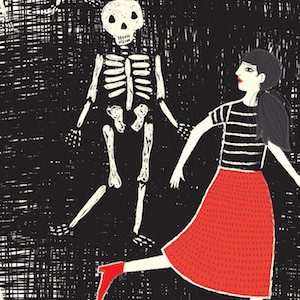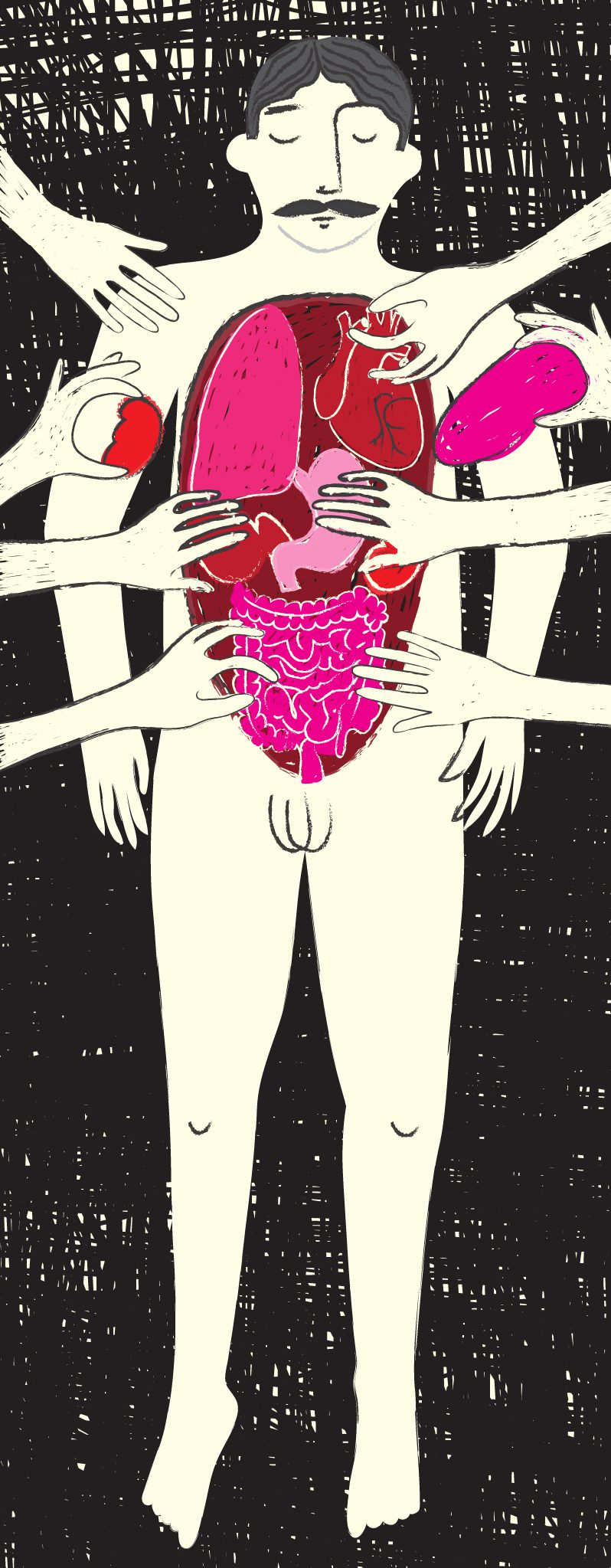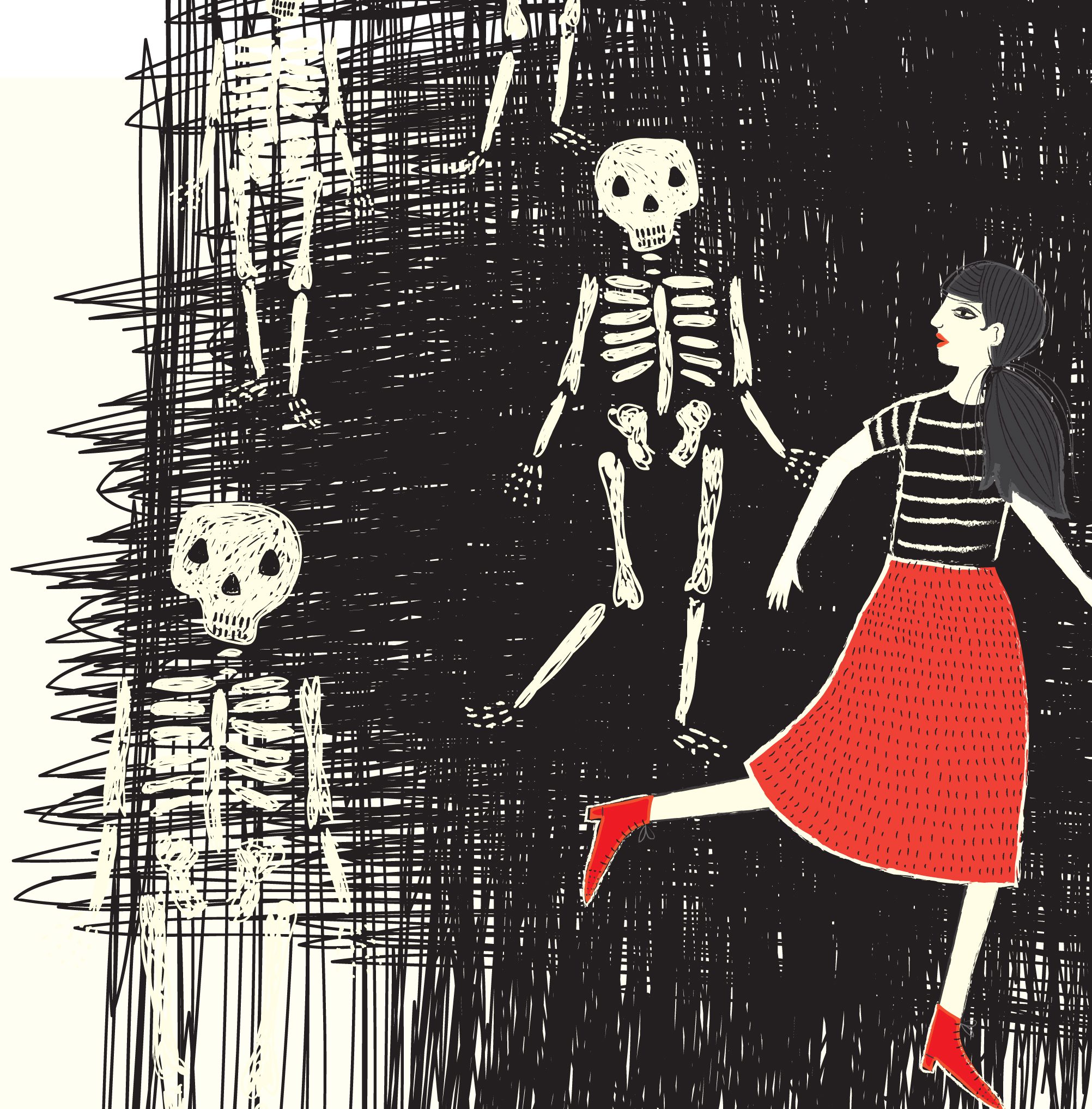
“People living deeply have no fear of death.”
–Anais Nin
I first saw death as a child, when I looked upon my mother.
Skeletal from years of anorexia, gray skin that stretched painfully over each protruding bone, sunken eyes that looked but never saw, and a smell that wafted from her that could never quite be placed. I now know it was the scent a person gives off when they are dying — cellular breakdown, a growing stench of rot.
She would ask me to massage her back, where the cavern of her ribs would push outward as she arched her spine — I can still feel my hand moving along the length of it, my finger tracing the dip of each vertebrae, the valleys between each rib.
As a little girl I had a recurring nightmare of a skeleton chasing me. The skeleton never spoke so I can’t be sure, but I think it was my mother. While other children looked forward to Halloween, I dreaded the eve; skeleton smiles were everywhere I turned, their bony fingers reaching for me — begging me to help them find their skin.
I encountered death again — in the flesh you could say — when I was twenty-one years old. I was observing an autopsy at the hospital where I was working. The surgical mask clung to my face like a hand, but the distinctive aroma of formaldehyde and an oddly familiar petrichor of decay still permeated the barrier, awakening memories.
Mum, propped upright in a recliner where she spent all day and night, staring at nothing but the darkness that shrouded the room. All the drapes were kept drawn, the lights off, the room kept frigidly cold. It was as though she were being kept in a mausoleum. Mum the mummy, I’d think, a laugh-sob catching in my throat.
The last memory I was meant to have of her was the day we took her to a hospital so she could die somewhere other than our house, which we didn’t want her to haunt. I sat in the backseat with her—all fifty-eight pounds of anguish that she was—and whenever she opened her mouth to scream in her delirious protestations, a scent wafted out that was somewhere between sodden dirt and blood.
My grandmother slammed on the breaks as we careened along the highway and I went crashing onto the floor. She turned off onto the exit for the hospital and as we spend along I-95 I sneered at my mother that I damn well hoped she would die, at last, so that we could all have some peace.
She slapped me hard across the face, and it startled me. Not that she’d thought to do it, but rather, that she’d somehow found the strength. It hadn’t even hurt me—with my high cheekbones and twelve-year-old certitude. But my mother’s hand, her bony fingers, turned to dust.
*
The man on the autopsy table had thin fingers, bony spines that were curled in a painful-looking rigor mortis. I pressed on, despite what death reminded me of. I was, after all, there to learn not about myself — but all of us, through the teachings of one of us. Or, as it were, what remained.
If you’ve ever wondered, the sound of ribs being cracked with hedge clippers is a vulnerable crunch; the cage that has kept the heart safe gives way to groping hands. The organ itself comes out strangely passive; a heart that fails to beat produces an air of primal discontent in the viewer. For nothing is more demonstrative of the finality of death than a motionless heart.
Mum’s heart had stopped once, but they shocked it back. She had a feeding tube for months, too long in fact. It permanently damaged her nose, the cartilage being so constantly assaulted by a nasogastric tube that she despised not because it pained her, but for its nourishment. Refeeding, they called it, and as the thick, sweet liquid dripped down her throat her body raged against it. The irony was, she nearly died when they tried to feed her. Every cell in her body warred against the invasion.
The internal landscape of the human body is almost too intricate to fathom; the universe under our skin is as complex as the fabric of the cosmos. Beneath the organs lies a web of nerves and blood vessels that hold within it the elixirs of human life: blood, plasma, and the old paths forged by electrical impulses to and from the brain.
We also hold within us a small ocean, our organs and cavities engorged with fluid. Even within a freshly deceased body, the organs are supple, filled with the water that once gave us life.
Looking inside someone else’s body, though, comes with spiritual paralysis.
I was far less bothered than I expected to be. I had seen, lived with, made feeble attempts to suckle love from, the walking dead. A corpse lying motionless on the table didn’t frighten me, because I’d been born to one that staggered and swore, stumbling toward me day after day, trying to pull me down beneath the surface of the earth.
In that first moment that you stare upon death—the unmoving kind—the weight of your mortality is lifted and you instead are filled with a sense of calm; death is as natural as birth and though you gaze upon something so unnatural as the decimation of a human corpse, you feel no spirit radiating from that flesh. It is not like looking upon a friend or a stranger on the street, whose spirit leaks from each orifice. Instead, you understand that you are looking at merely a hull; life left them long before you got there, and you are at peace with what you see left in its spectral wake.
It’s that place between life and death that haunts you, as you watch someone rotting in real time, see in their eyes that last flicker of themness, the final mutter of life. When you watch the hull drape itself over wingback chairs and hospital beds, trying to decide whether to stay or go.
It’s better when the dead are truly dead, I think, looking down at the carefully cut open cavity in front of me. In such a moment, you are aware that only days ago these glistening organs were filled with molecular activity; they buzzed and pulsated, blood coursed through them as they kept this person alive.
You are heavily reminded of this when you watch as the pathology tech rinses the leftovers from the intestinal tract, the only evidence that this body had not long ago enjoyed one of life’s greatest pleasures — food.
If Mum had died when she half-died, when her heart gave up and greedy doctors brought her back, what would have rinsed from her digestive tract? No food; only watery guilt.
Watching the contents of this man’s stomach circle the drain, I wondered what of this Earth he last tasted, last smelled, last heard — last felt? If Mum had died, what would her last taste have been, blood from her chapped, cracked lips? The last smell the hot plastic of that tube? Last heard, the nurses tutting at her. Last felt—last felt?—I don’t know what she felt. I don’t know that she could.
I look at the face of this stranger before me, frozen in his final moment: what words passed his lips on his last breath. What did he see before life left his eyes? Was it something that made him happy?
When the body is all but empty, and the only thing left is the brain, which is still inside the skull, still is covered in the face that once belonged to the person who has now been reduced to floppy skin, broken bones and a pile of discarded organs.
A dilapidated body that still retains a human face.
The skin of the skull is sliced with a scalpel, starting at the top, just at the hairline. The forehead is pulled down over the face. The skull, cracked open like a nut, holds within it the brain, the pink flesh that mounts us so highly above the other of Earth’s many creatures.
Though it appears to be not much more than tissue, the brain holds within it all that makes us human. With the peaks and valleys of that flesh, the ridges and the smallest pathways not visible to the naked eye, this man’s journey through the mortal coil has been forever encapsulated.
The brain of someone elderly has seen so much they can’t remember.
The brain of someone young has not seen enough to know.
When I pull off my latex skin, feel the cool air of the morgue rush against my bare hands as I take off all the plastic that is meant to protect me from — I’m not sure what — I teem with life, and the memories earlier stirred curl up again into fitful sleep.
I wonder what lives inside my mother, waiting to take her. I wonder what lives inside of her that keeps her alive.
That night I lay in bed and am wide awake, wide alive, so hyperaware of my own existence and eventual ceasing-to-be, and for the first time in many, many years, the skeletons run in my dreams.
I wonder what lives inside my mind waiting to take me. I wonder what lives inside of my mind that keeps me alive.
***
Rumpus original art by Stephanie Hofmann.








